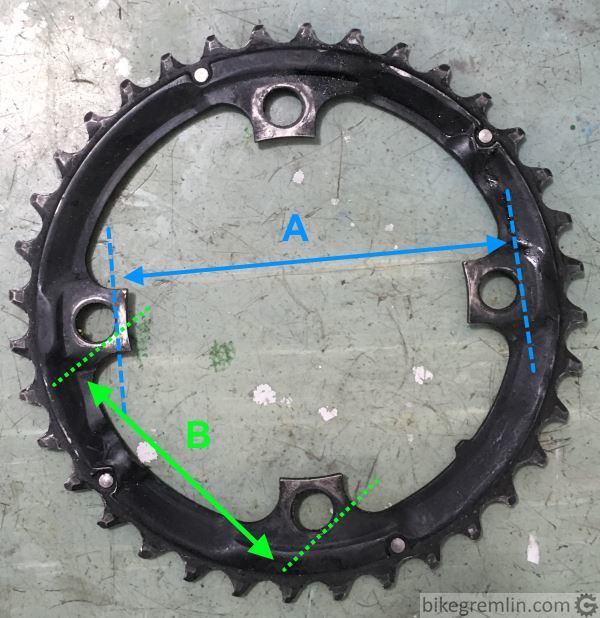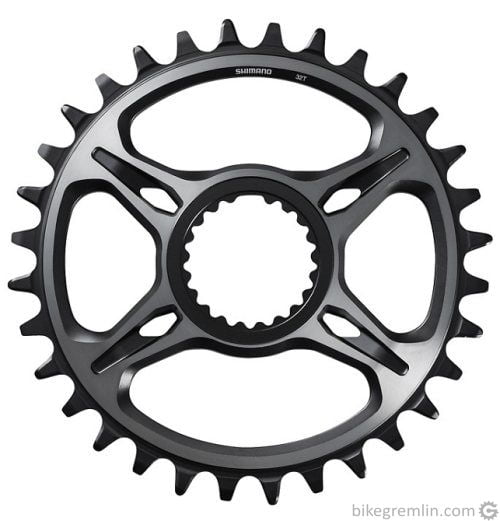How to measure the front chainring mounting hole width, so you can buy a matching one?
Higher classes of cranks usually have chainrings that are separately replaceable. The problem many people face is choosing a correct (matching) chainring for their model of cranks. In this post I will explain what chainring mounting standards exist and how to tell which one you need.
If you have any questions (or additions and corrections), please use the BikeGremlin forum:
www.bikegremlin.net
Table Of Contents (T.O.C.):
- Chainring mounting standards
- Measuring BCD
2.1. Measuring BCD of 5 bolt mounted chainrings
2.2. Measuring BCD of 4 bolt mounted chainrings - Directly mounted chainrings
- Sources
1. Chainring mounting standards
There are four groups of mounting standards for front chainrings:
- With 5 bolts (older standard)
- With 4 bolts (current)
- Shimano 11 speed Ultegra and Dura Ace – 4 bolts, but using different layout, non-standard
- “Direct mount” (newest standard) – SRAM and Shimano having different standards
With the first two standards, all the bolts (whether there are 4, or 5) are placed at the same distance from the crank axle and with the same spacing between adjacent bolts. What differs between 4 and 5 bolt chainring mounting standards is the diameter of a circle along which all the mounting bolts (centres) are placed. That is called BCD (Bolt Circle Diameter) – picture 1 explains it better:

Picture 1
The problem is that, for example: two 5 bolt mounted chainrings don’t always have the same BCD, so this needs to be measured when looking for a new (replacement) chainring. Measuring procedure will be explained in chapters below.
2. Measuring BCD
The dimension that we need is from centre to centre. However, I find it hard to measure that accurately, so I measure from end to end, using vernier calipers, as shown in picture 2 (it gives the same dimension, just using a different method).

Picture 2
BCD affects two things:
- Will a chainring fit the cranks at all.
- The minimum size (number of teeth) that a chainring can have (the larger the BCD, the larger the “smallest fitting chainring” will be, of course).
2.1. Measuring BCD of 5 bolt mounted chainrings
With these chainrings BCD can not be measured “directly”, by measuring the distance between any two non-adjacent bolt centres. It takes measuring the distance of two adjacent bolts, then multiplying it by 1.7 and/or look at (the nearest standard BCD size in) the table 1 provided here. What needs measuring is shown in the picture 3 (marked with “B”):

Picture 3
Table 1 gives a list of standard sizes of 5 bolt mounted chainring BCD-s. C-C (“B” in picture 3) is the distance between adjacent bolt centres, while MIN is the smallest chainring tooth count that can fit the given BCD. All the sizes are given in millimetres (divide with 25.4 to get inches).
Table 1
| BCD | C-C (adjacent holes) | MIN tooth count | Crank models |
| 151 | 88.8 | 44 | Very old Campagnolo standard (pre ’67) (Obsolete) |
| 144 | 84.6 | 41 | Old Campagnolo standard, still used for track applications. |
| 135 | 79.4 | 39 | Current Campagnolo standard |
| 130 | 76.4 | 38 | Standard Road double and triple (outer 2 chainrings) |
| 128 | 75.2 | 38 | Nervar Sport, Star (Obsolete) |
| 122 | 71.7 | 38 | Stronglight 93, 101, 103, 104, 105 (Obsolete) |
| 118 | 69.4 | 36 | Ofmega, SR (Obsolete) |
| 116 | 68.2 | 35 | Old Campagnolo (Obsolete) |
| 110,112 | 64.7, 65.2 | 34 | Campagnolo CT inner/middle/outer with one bolt at a larger BCD behind the crank |
| 110 | 64.7 | 33 | Touring double, standard triple outer, road compact double outer chainring |
| 102 | 60.0 | 32 | Avocet triple inner (obsolete) |
| 100 | 58.7 | 31; 36 | Merz adapter; Campagnolo triple inner (obsolete) |
| 94 | 55.4 | 29 | Compact triple outer |
| 92 | 53.3 | 30 | Shimano Dura-Ace triple inner (old) |
| 90 | 52.9 | 30 | Edco, Mavic triple inner (old) |
| 86 | 50.5 | 28 | Stronglight 80, 99, 100, SR Apex (Obsolete) |
| 85 | 50.0 | 28 | Old Shimano Deore, Takagi triple inner (Obsolete) |
| 80 | 47.0 | 26 | Tevano (TA Campagnolo clone) triple inner. Bolts not interchangeable with others. |
| 74 | 43.5 | 24 | Standard (“full-sized”) triple inner, used with 110, 130, or 135 mm BCD outer chainrings. |
| 58 | 34.1 | 20 | Compact triple granny |
| 56 | 32.9 | 20 | Sun Tour Compact triple granny (Obsolete) |
2.2. Measuring BCD of 4 bolt mounted chainrings
Note:
Shimano made asymmetric 4-bolt chainrings. If you have such cranks, you must look for the matching chainrings – the ones without evenly spaced mounting holes (table 3).
Here it is possible to “directly” measure the BCD, but on can also measure the distance of adjacent bolt centres then multiply it with 1.41 (see table 2). Both methods are shown in picture 4.

Picture 4
Table 2 gives a list of standard sizes of 4 bolt mounted chainring BCD-s. C-C (“B” in picture 4) is the distance between adjacent bolt centres, while MIN is the smallest chainring tooth count that can fit the given BCD. All the sizes are given in millimetres (divide with 25.4 to get inches). Note that Shimano 11 speed Ultegra and Dura Ace do use 4 bolts, but with a different layout, non-standard one (of course).
Table 2
| BCD | C-C (adjacent holes) | MIN tooth count | Crank models |
| 146 | 103.2 | 44 | Shimano XTR M960 Hollowtech 4-arm outer |
| 120 | 84.9 | 36 | 1x |
| 112 | 79.2 | 34 | Shimano XTR M950, M952 4-arm middle/outer |
| 104 | 73.5 | 32 | ShimanoXT, LX 4-arm outer, Sugino MX350 |
| 102 | 72.1 | 32 | Shimano 2003 XTR MX960 4-arm middle |
| 96 | 67.9 | 30 | 1x |
| 94 | 66.5 | 30 | 1x |
| 88 | 62.2 | 28 | 1x |
| 68 | 48.1 | 22 | Shimano XTR M950, M952 4-arm inner |
| 64 | 45.3 | 22 | Shimano XTR M960, XT, LX 4-arm inner |
| 58 | 41.0 | 20 | Sugino MX350 4-arm inner |
Table 3 – asymmetric 4-bolt chainrings
| BCD | Adjacent hole spacing (varies with asymmetric chainrings) |
|---|---|
| 76 mm | 49; 62.4; 53.9 mm |
| 96 mm | 55.2; 78.8 mm |
| 110 mm | 63.6; 90.6 mm (Shimano) |
3. Directly mounted chainrings
Current trend is the introduction of directly mounted chainrings. Direct in mount means that chainrings are mounted at the crank’s base, not mounted to a spider that is an integral part of the crank.

Picture 5
As far as I know, every larger manufacturer has their own standard, not-interchangeable with other manufacturers’ standards. So (for) now we have: Race Face Chinch, Cannondale, SRAM and Shimano XTR M9100. The chainring mounting grooves must match the mounting splines of the crank.
Here when replacing chainrings it is important to mind the chainline that they provide. This often depends on the crank model, but some manufacturers of replacement chainrings (Wolf Tooth for example) offer various models depending on the desired chain line.
4. Sources
- Sheldon TheCyclingMechanicsBible Brown BCD Crib Sheet
- Wolf Tooth – How to measure Bolt Circle Diameter (BCD)
- Singletrack – Wolf Tooth Announces New Chainring Standard
- ChainReactionCycles – Chainring buying guide
If you have any questions (or additions and corrections), please use the BikeGremlin forum:
www.bikegremlin.net

